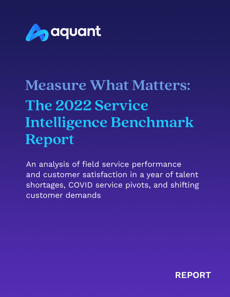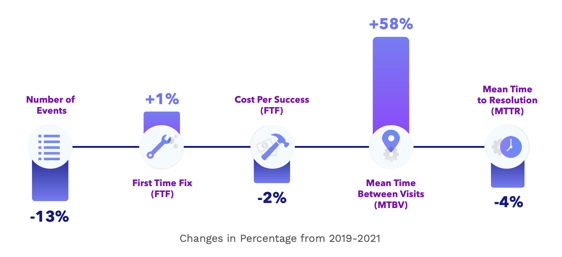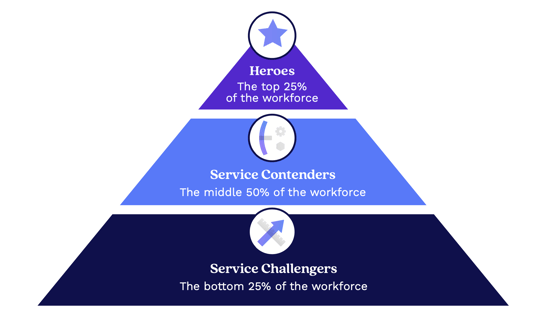In this final feature from a recent white paper we published in partnership with Exel Computer Systems, we shall take a look at consideration for ensuring the platform you select is one you can have faith in.
ARCHIVE FOR THE ‘digital-transformation’ CATEGORY
Nov 16, 2021 • Features • White Paper • Digital Transformation • Exel Computer Systems • Data Management
In this final feature from a recent white paper we published in partnership with Exel Computer Systems, we shall take a look at consideration for ensuring the platform you select is one you can have faith in.

This feature is just one short excerpt from a recent white paper we published in partnership with Exel Computer Systems.
www.fieldservicenews.com subscribers can read the full white paper now by hitting the button below.
If you are yet to subscribe you can do so for free by hitting the button and registering for our complimentary subscription tier FSN Standard on a dedicated page that provides you instant access to this white paper PLUS you will also be able to access our monthly selection of premium resources as soo as you are registered.

Data usage note: By accessing this content you consent to the contact details submitted when you registered as a subscriber to fieldservicenews.com to be shared with the listed sponsor of this premium content Exel Computer Systems who may contact you for legitimate business reasons to discuss the content of this white paper, as per the terms and conditions of your subscription agreement which you opted into in line with GDPR regulations and is an ongoing condition of subscription.
As we have seen in the paper so far, there are a lot of benefits to the platform approach. However, there is one significant draw that can cause hesitancy in many companies – relying on one provider.
In the concluding part of this paper, we shall take a look at consideration for ensuring the platform you select is one you can have faith in...
Reliance on a single solution provider is, of course, the natural counterbalance of having one platform and one provider being integral to so many mission critical aspects of your business. For every company, the
decision as to whether the risk/reward ratio of taking the platform approach is suitable may be different.
However, having provided a small outline of just some of the benefits of the platform approach, in this concluding section of this paper we shall outline some of the key considerations that could help you mitigate risk on the other side of the equation.
When considering any platform provider you should consider the following:
WHAT IS THEIR TRACK RECORD OF WORKING WITH ORGANISATIONS LIKE MINE?
This should always be the starting point – how well will this company genuinely understand our needs? However, this doesn’t necessarily mean that you should be looking at a solution provider that only serves your particular industry vertical, or even one that caters to companies of similar size, be it enterprise or SMB.
One of the most consistent themes within Field Service News discussion groups is that so many of the pain points of field service operations are shared across vertical industries. Yet, the insight from outside your vertical sector can often help reflect on a problem – and show ways to overcome it from a new perspective.
Similarly, there are learnings from smaller, more nimble organisations that can help larger companies; and best practices of the enterprise that SMBs can adopt to improve efficiencies.
The solution provider who has that broad experience across different industry verticals, with clients of all sizes that can demonstrate that they not only understand the challenges you face but also that they have helped companies with similar needs, will be worth their weight in gold when it comes to not only improving your workflow but, perhaps most importantly, guiding you to avoid the common pitfalls you might otherwise have faced.
DO THEY HAVE A SOLID FINANCIAL POSITION?
This next consideration is essential for two key reasons. The first and perhaps more prominent of the two is that the last thing you want is to implement a solution across your business only for the provider to cease trading a year or two down the line, leaving you with what will quickly become an outdated legacy product that ultimately will cause more harm than good.
So the first key is to assess the long-term financial health of the business. Generally, if a solution provider is financially robust, this will be woven into their sales pitch at some level, but never be afraid to ask. Additionally, a look through their current customer roster can be a strong indicator of business strength. Many companies using the product, including some with strong brand recognition, can often be another indicator of a healthy and profitable business.
However, the second reason this is a crucial consideration is probably even more critical. A solid and healthy balance sheet allows for consistent investment into research and development.
For example, Exel Computer Systems solutions are under continuous development and have been since inception – the development never ends – one of the key reasons they have such strong loyalty within their customer base.
SHAPING THE FUTURE DEVELOPMENT ROADMAP
Another aspect for consideration that leads neatly on from this is understanding how responsive the solution provider is to customer input in terms of future developments?
This is an area where perhaps you may be better served by selecting a platform provider that is more accessible than the behemoths of the tech industry that may be the more appealing at first glance.
Does the solution provider host regular user groups? Is there a mechanism for feature requests? What is the success of such programs?
These are all questions that can indicate how responsive the platform provider may be to working with you to enhance further and refine the solution, or even introduce new modules to the platform entirely.
IS THE PLATFORM MODULAR?
This brings us to our final point for consideration – does the platform have a modular structure?
As we mentioned at the top of this section, there are many shared pain points across the field service sector. However, every business remains unique, and every company will have different needs.
Introducing new modules as additional requirements arise can allow a platform to offer the easy data flow we discussed in the first section of this paper, yet provide the flexibility that we often see as a highly celebrated benefit of a best- of-breed technology stack approach.
A modular-based platform also allows for more straightforward implementation. The old maxim that you can’t boil the ocean is especially true for mission-critical software implementation. The possibility of easing the implementation with a modular platform, particularly if deployed across multiple business units, allows for a much smoother transition.
"The old maxim that you can’t boil the ocean
is especially true for mission-critical software implementation..."

This feature is just one short excerpt from a recent white paper we published in partnership with Exel Computer Systems..
www.fieldservicenews.com subscribers can read the full white paper now by hitting the button below.
If you are yet to subscribe you can do so for free by hitting the button and registering for our complimentary subscription tier FSN Standard on a dedicated page that provides you instant access to this white paper PLUS you will also be able to access our monthly selection of premium resources as soo as you are registered.
 Data usage note: By accessing this content you consent to the contact details submitted when you registered as a subscriber to fieldservicenews.com to be shared with the listed sponsor of this premium content Exel Computer Systems who may contact you for legitimate business reasons to discuss the content of this white paper, as per the terms and conditions of your subscription agreement which you opted into in line with GDPR regulations and is an ongoing condition of subscription.
Data usage note: By accessing this content you consent to the contact details submitted when you registered as a subscriber to fieldservicenews.com to be shared with the listed sponsor of this premium content Exel Computer Systems who may contact you for legitimate business reasons to discuss the content of this white paper, as per the terms and conditions of your subscription agreement which you opted into in line with GDPR regulations and is an ongoing condition of subscription.
Further Reading:
- Read more about Digital Transformation @ www.fieldservicenews.com/digital-transformation
- Read more about Data Management @ www.fieldservicenews.com/data-management
- Read more about Exel Computer Systems on Field Service News @ www.fieldservicenews.com/exel
- Learn more about Exel Computer Systems @ www.exel.co.uk
- Follow Exel Computer Systems on Twitter @ twitter.com/exelcomputersys
Nov 11, 2021 • Features • Digital Transformation • Aquant • Covid-19 • customer experience
Aquant, has recently published the 2022 Service Intelligence Benchmark Report, now available at Field Service News, which offers an in-depth analysis of field service performance and customer satisfaction in a year of talent shortage, COVID service...
Aquant, has recently published the 2022 Service Intelligence Benchmark Report, now available at Field Service News, which offers an in-depth analysis of field service performance and customer satisfaction in a year of talent shortage, COVID service pivots, and shifting customer demands.

This feature is just one short excerpt from a report published by Aquant
www.fieldservicenews.com subscribers can read the full report now by hitting the button below.
If you are yet to subscribe you can do so for free by hitting the button and registering for our complimentary subscription tier FSN Standard on a dedicated page that provides you instant access to this white paper PLUS you will also be able to access our monthly selection of premium resources as soo as you are registered.
 Data usage note: By accessing this content you consent to the contact details submitted when you registered as a subscriber to fieldservicenews.com to be shared with the listed sponsor of this premium content Aquant who may contact you for legitimate business reasons to discuss the content of this white paper, as per the terms and conditions of your subscription agreement which you opted into in line with GDPR regulations and is an ongoing condition of subscription.
Data usage note: By accessing this content you consent to the contact details submitted when you registered as a subscriber to fieldservicenews.com to be shared with the listed sponsor of this premium content Aquant who may contact you for legitimate business reasons to discuss the content of this white paper, as per the terms and conditions of your subscription agreement which you opted into in line with GDPR regulations and is an ongoing condition of subscription.
In this comprehensive data report, Aquant analyzed how service organizations and their workforce measureD up against industry benchmarks.
We also explored service performance from a customer perspective. Aquant analyzed more than six million service tickets to reveal:
-
A snapshot of the overall industry and how companies measure up against each other
-
The reason why hitting your KPIs rarely equates to outstanding customer experiences
-
The spiraling impact of a missed First Time Fix (FTF) event
-
An increase in the workforce skills gap
-
COVID-19’s impact on service
We provide recommendations to:
-
Start making immediate business improvements by looking at service performance in a comprehensive way
-
Boost the customer experience in the short-term and long-term
-
Upskill a team in the face of a talent shortage
-
Succeed amid post-Covid service disruptions
KEY FINDINGS
KPIs Are Only as Meaningful As How You Measure Them
First Time Fix is a Distorted Barometer of Service Quality
Organizations that monitor KPIs in isolation may think they are hitting their numbers and providing great service. However, there’s a good chance that they are providing sub-par customer experiences.
Organizations that measure FTF rates at seven days or 14 days actually have much lower long-term success rates than their dashboards reveal. This is because fixes marked as complete on day one often require additional visits on day two through day 14 to fix a persistent problem that may have been incorrectly or inadequately addressed on the first visit. For example, if you wrap a leaking hose with duct tape to stop a leak, you’ve put a bandaid on a problem without fixing the root issue. The customer may call to reopen that ticket when they discover another leak in the following week.
-
86.6% is the FTF rates when measured in 7-day windows
-
81.5% is the FTF rates when measured in 14-day windows
-
75% is the FTF rates when measured in 30-day windows
The other argument against relying too heavily on FTF rates is that high values often mask other issues, such as:
-
Employees who shotgun parts to hit KPIs
- High labor costs due to labor to over-reliance on industry veterans
The way organizations provide service today is not in tune with customer expectations. Even with an average FTF rate, one in every four jobs requires at least one repeat visit.
Variations on FTF measurements are one reason for the disconnect. Other contributing factors include:
- Lack of insights into an organization’s core health
- A workforce labor shortage
- Inability to connect the dots between service performance and customer experience
- Reactive vs. proactive service
In 2021, service organizations faced even larger hiring challenges than in the past. This has left the industry with tens of thousands of unfilled jobs, and some reports estimate there will be an industry-wide shortage of three million skilled trade workers in the next five years.
-
The bottom quarter of the workforce costs organizations 84% more than the top quarter. That’s 4% higher than last year.
-
- The top 20% of the workforce (service heroes) has a 75% FTF rate. The bottom 20% of the workforce (service challengers) has a FTF rate of 59%.
Mean Time to Resolution (MTTR) increased during COVID, showing that jobs were completed faster. Part of that increase is attributed to more service organizations adopting remote resolution technology. This technology helps customers address minor issues themselves through self-service solutions. It also enables service organizations to diagnose—and even repair—issues without the need to send a tech on-site, thus reducing time and costs.
This is also a sign of resiliency across service organizations, many of whom were able to adapt in the face of ever-changing circumstances.

The insights in this report, gleaned from actual service data, provides a path to service improvements through a multi-step process.
-
Learn how to accurately identify your organization’s core service problems by better understanding the patterns in your service data
-
Use those data patterns to drive actionable service recommendations—for management-level decisions and in-the-field fixes
-
Plan proactive customer experience enhancements
-
Make more informed workforce training and hiring decisions to shrink the skills gap
How We Compiled the Data
Aquant gathered and analyzed actual anonymized service data from more than 76 leading service organizations. The data in this report was measured before an organization deployed Aquant’s AI solution.
The report measures:
- 76 organizations, including service divisions within OEMs and third- party service organizations across manufacturing, medical devices, capital equipment, HVAC, commercial appliances, and more
- More than 6 million work orders
- More than 31,000 technicians
- $7 billion total in service costs
- An average of 3 years of service data per company
 How We Define the Service Workforce
How We Define the Service Workforce How is this Report Different from Standard Service Benchmarks?
How is this Report Different from Standard Service Benchmarks?• We analyzed real service data to understand the health and outlook of organizations instead of relying on service executives to self-report KPIs. Data sources included service tickets, CRM data, parts information, and more.
• We charted the skills gap. This makes it easy to extrapolate how much an organization can gain in efficiency and cost savings if the entire workforce was able to perform more like your experts.
• We analyzed the data using the Aquant Service Intelligence Platform, which includes a Natural Language Processing (NLP) engine built for the service industry. This lets us dig deep into data ranging from CRM and parts inventory to service tickets, handwritten records, and other information that never makes it into any databases. We are able to draw out patterns and recommendations based on raw data.

This feature is just one short excerpt from a report published by Aquant.
www.fieldservicenews.com subscribers can read the full report now by hitting the button below.
If you are yet to subscribe you can do so for free by hitting the button and registering for our complimentary subscription tier FSN Standard on a dedicated page that provides you instant access to this white paper PLUS you will also be able to access our monthly selection of premium resources as soo as you are registered.
 Data usage note: By accessing this content you consent to the contact details submitted when you registered as a subscriber to fieldservicenews.com to be shared with the listed sponsor of this premium content Aquant who may contact you for legitimate business reasons to discuss the content of this white paper, as per the terms and conditions of your subscription agreement which you opted into in line with GDPR regulations and is an ongoing condition of subscription.
Data usage note: By accessing this content you consent to the contact details submitted when you registered as a subscriber to fieldservicenews.com to be shared with the listed sponsor of this premium content Aquant who may contact you for legitimate business reasons to discuss the content of this white paper, as per the terms and conditions of your subscription agreement which you opted into in line with GDPR regulations and is an ongoing condition of subscription.
Further Reading:
- Read more about Aquant on Field Service News @ www.fieldservicenews.com/aquant
- Read more about Digital Transformation @ www.fieldservicenews.com/digital-transformation
- Read more about Leadership & Strategy @ www.fieldservicenews.com//leadership-and-strategy
- Learn more about Aquant @ www.aquant.io
- Follow Aquant on Twitter @ twitter.com/Aquant_io
Nov 09, 2021 • Features • White Paper • Digital Transformation • Exel Computer Systems • Data Management
In the second feature from a recent white paper we published in partnership with Exel, we outline how an API works and why service organisations should invest in a series of best-of-breed solutions and combine them all in a technology stack.
In the second feature from a recent white paper we published in partnership with Exel, we outline how an API works and why service organisations should invest in a series of best-of-breed solutions and combine them all in a technology stack.

This feature is just one short excerpt from a recent white paper we published in partnership with Exel Computer Systems.
www.fieldservicenews.com subscribers can read the full white paper now by hitting the button below.
If you are yet to subscribe you can do so for free by hitting the button and registering for our complimentary subscription tier FSN Standard on a dedicated page that provides you instant access to this white paper PLUS you will also be able to access our monthly selection of premium resources as soo as you are registered.

Data usage note: By accessing this content you consent to the contact details submitted when you registered as a subscriber to fieldservicenews.com to be shared with the listed sponsor of this premium content Exel Computer Systems who may contact you for legitimate business reasons to discuss the content of this white paper, as per the terms and conditions of your subscription agreement which you opted into in line with GDPR regulations and is an ongoing condition of subscription.
In the previous feature from this white paper, we looked at how the easy flow of data across various modules within a platform can improve both the efficiency of your service delivery and ensure you are meeting your customers’ expectations. However, in a world of APIs where everything is expected to work wonderfully and connect via plug and play, why shouldn’t a service organisation invest in a series of best-of-breed solutions and combine them all in a technology stack?
As a starting point, let us first take a moment to better understand what an API (Application Programming Interface) actually is. Indeed, API is an acronym often thrown into a conversation but perhaps not so well understood for those of us who are not software experts.
To outline how an API works, let us take a more straightforward example.
Imagine you’re a diner in a restaurant with a menu of choices to select from. The kitchen is the part of the ‘system’ that will prepare your meal. However, you cannot just go to the kitchen and place your order directly; this would slow the Chef down and delay service for you and everyone else in the restaurant.
The critical link required for you to communicate your order to the Chef and deliver your food to your table is a waiter.
At a very rudimentary level, the waiter is an API. They are the messenger that takes your request and informs the Chef of what is needed. Then when the Chef completes the task, the waiter returns to deliver the response (in this case, your meal) back to you.
So far, so good.
However, now let’s expand the analogy to fit better the many moving parts of a mission-critical activity, such as field service. In a best-of-breed technology stack, we are no longer dealing with one waiter; we are dealing with a waiter for each aspect of the meal. One Waiter to take our order for our appertisers, another for our entrée. We have a Concierge to ensure we are sat at an adequate table, a Sommelier to take our wine order, a Dessert Waiter and so forth.
Then each of these additional waiters will be linking back to a different part of the restaurant.
The Commis Chef will be responsible for delivering one part of the meal, the Sous Chef another, Chef de Partie another. The Bartender is responsible for providing drinks expertly recommended by the Sommelier, and working in an entirely different part of the building.
Anyone who has been to a high-end restaurant will know that such complexity can be managed and delivered effectively to drive a standard of service that is exceptional.
However, anyone who has worked in such a restaurant will tell you that it takes a phenomenal amount of work to keep the lines of communication and the flow of productivity moving across the shift. Indeed, this is why good restaurant managers that can keep all of these connections, these ‘human APIs’, working in unison, are worth their weight in gold.
"With a platform approach, the links between modules are within the architecture of the solution itself, updates would have been fully tested system- wide prior to deployment. Should an issue occur, you have one point of contact to seek swift resolution..."
However, for the field service organisation, whose function is to serve their customers, not manage a complex web of systems and technology, is this an optimum approach?
In a best-of-breed technology stack, a company becomes exposed to various elements, reliant on multiple APIs being aligned across numerous updates.
As with the restaurant example, managing this takes a lot of work. Any one of the elements the stack is comprised of could become a broken link the chain, having a knock-on effect across the stack. It has to be questioned whether such a complex solution is worth the risk.
For example, if the integration between two integral systems within your technology stack fails, to which of the two providers should you turn to resolve the issue?
With a platform approach, the links between modules are within the architecture of the solution itself, updates would have been fully tested system- wide prior to deployment. Should an issue occur, you have one point of contact to seek swift resolution. With a platform approach, a lot of the responsibility shifts onto your solution provider to make things work. Of course, this also means less heavy lifting required from your internal IT team.
With the technology stack, your IT team can spend all of their time making the multiple solutions talk to each other, bouncing from one solution provider to the next in an endless cycle of updates and new integrations.
This can be a drain on resources, both financially and in terms of man-hours, both of which could be better spent focusing on growing your business and keeping your customers happy.
As we saw in the previous section, the seamless flow of data across an organisation can be the difference between service failure or service excellence.
Do you really want to be exposed to multiple potential weak links in the chain, especially when the one platform approach overcomes this?

This feature is just one short excerpt from a recent white paper we published in partnership with Exel Computer Systems..
www.fieldservicenews.com subscribers can read the full white paper now by hitting the button below.
If you are yet to subscribe you can do so for free by hitting the button and registering for our complimentary subscription tier FSN Standard on a dedicated page that provides you instant access to this white paper PLUS you will also be able to access our monthly selection of premium resources as soo as you are registered.
 Data usage note: By accessing this content you consent to the contact details submitted when you registered as a subscriber to fieldservicenews.com to be shared with the listed sponsor of this premium content Exel Computer Systems who may contact you for legitimate business reasons to discuss the content of this white paper, as per the terms and conditions of your subscription agreement which you opted into in line with GDPR regulations and is an ongoing condition of subscription.
Data usage note: By accessing this content you consent to the contact details submitted when you registered as a subscriber to fieldservicenews.com to be shared with the listed sponsor of this premium content Exel Computer Systems who may contact you for legitimate business reasons to discuss the content of this white paper, as per the terms and conditions of your subscription agreement which you opted into in line with GDPR regulations and is an ongoing condition of subscription.
Further Reading:
- Read more about Digital Transformation @ www.fieldservicenews.com/digital-transformation
- Read more about Data Management @ www.fieldservicenews.com/data-management
- Read more about Exel Computer Systems on Field Service News @ www.fieldservicenews.com/exel
- Learn more about Exel Computer Systems @ www.exel.co.uk
- Follow Exel Computer Systems on Twitter @ twitter.com/exelcomputersys
Nov 08, 2021 • News • Live video streaming • Microsoft • Digital Transformation • EMEA • Customer Service • ADTANCE
ADTANCE, a leading international After-Sales Service technology platform provider for manufactures, industrial companies and mechanical engineering organizations, announced the integration of ADTANCE Smart Services with Microsoft Teams, providing...
ADTANCE, a leading international After-Sales Service technology platform provider for manufactures, industrial companies and mechanical engineering organizations, announced the integration of ADTANCE Smart Services with Microsoft Teams, providing users with a comprehensive solution for industrial customer service.Teams users can utilize ADTANCE Smart Services for digitizing the entire customer service lifecycle including live remote customer support, ticketing, document management, workflow and predictive maintenance.
“Many manufacturing, engineering and industrial organizations already use Microsoft Teams for video conferencing, team chats and sharing documents,” said Nils Arnold, CEO and co-founder of ADTANCE. “Having the ADTANCE customer service functionality within the same application that is already part of users everyday workflow can increase work efficiency and improve customer service.”
TEAMS UERS GAIN NEW OPTION FOR INTEGRATED CUSTOMER SUPPORT WITH UNIQUE MULTI-CAMERA LIVESTREAMING VIDEO CAPABILITIES
“As a world leader in specialty chemicals, we employ more than 30,000 people in 100 countries,” said Dr. Christian Blaufelder, Leiter Commercial Interface & Development, Technical Service, Evonik Industries. “Our service technicians across the globe are avid users of both Microsoft Teams and ADTANCE Smart Services. Having ADTANCE’s multi-camera live video and customer support functionality integrated into Teams will enable us to deliver high quality remote customer service and collaboration, while boosting productivity.”
“Microsoft Teams enables users around the world to collaborate with no limits in time and space,” said Marie Therese Fontaine, Microsoft Teams Business Lead at Microsoft Germany. “ADTANCE Smart Services extends Teams with a comprehensive range of customer service and collaboration capabilities for industrial organizations. “Manufacturers and engineering companies with locations across the globe have the convenience of using a single, robust solution for both team collaboration and customer service.”
The ADTANCE Smart Services solution is available as an installable application through Microsoft App Source. Users can login with their Teams credentials and benefit from the full scope of the ADTANCE Smart Services, which includes the new ADTANCE Support and Fieldstreaming solution—live remote video support software capable of connecting smart glasses with every type of camera to the system. Cameras include those within smartphones, tablets, computers, security cameras, drones and underwater Remote Operated Vehicles (ROVs), as well as Microsoft HoloLens. Manufacturing and engineering organizations can livestream views of machines from various angles simultaneously – significantly improving customer support, remote machine maintenance and training in the field.
The ADTANCE Smart Services integrated into Teams include the following:
ADTANCE Support – Enables live remote support, inspection and maintenance for customers, utilizing devices such as smart glasses and multi-camera fieldstreaming.
ADTANCE Workflow – Digitizes, analyzes, and optimizes all workflows, including everyday processes such as maintenance instructions.
ADTANCE Process Visualization and Monitoring (PVM) - Monitors the performance of individual machines as well as entire industrial plants.
ADTANCE Predictive Maintenance (PM) - Analyzes and evaluates operational data in real time through the continuous monitoring of machines or the entire production plant using built-in sensors. Machine learning-based analysis offer predictions about potential downtime as well as warnings if a piece of equipment will require maintenance.
ADTANCE Ticketing - Standardizes entire customer service channels by bundling different channels into one system, including e-mail, telephone, SMS and social media. Creates order and clarity by providing different escalation levels with the respective reaction and resolution times.
ADTANCE Document Management (DM) - Stores all customer service documents centrally, and controls access rights for security and privacy purposes.
ADTANCE Parts – A central catalogue system to ensure that all spare part information remains centrally located and easily discoverable.
Further Reading:
- Read more about Digital Transformation @ www.fieldservicenews.com/digital-transformation
- Read more about Customer Service @ www.fieldservicenews.com/customer-service
- Learn more about ADTANCE @ www.adtance.com
- Follow ADTANCE on Twitter @ twitter.com/adtance
- Connect with ADTANCE on LinkedIn @ www.linkedin.com/company/adtance
Nov 04, 2021 • Features • Digital Transformation • technology • Aquant • GLOBAL
In this article from Aquant, we look at three tips to secure approval for new service projects and how to make the right decision for your organisation.
In this article from Aquant, we look at three tips to secure approval for new service projects and how to make the right decision for your organisation.
How to Make the Right Decision For Your Organisation
Artificial intelligence is becoming an essential tool for the service sector — aiding in everything from service delivery and customer support, to employee training.
With nearly 50% of companies reporting that they’ve adopted AI in at least one business function, trends indicate that tech-forward companies are past figuring out if they should lean on AI’s capabilities. Instead, they’re figuring out when they’ll make the investment and how they will implement it.
As companies weigh the pros and cons of adoption, an even bigger question arises: is it better to build a solution in-house or buy it from a vendor?
Ultimately, the questions you should consider are:
· Which option delivers maximum organizational benefit?
· What is the difference in deployment time for building vs. buying?
· How much will it cost to build vs. buy?
· What internal resources or additional consultants will be needed for each option?
· If a quick-to-implement solution fits your organization’s needs, will it offer better ROI in comparison to building a perfect, custom solution that may take twice as much time and resources?
It’s about what offers the biggest benefit to your organization. Here are a few expert tips for figuring out which path is the best fit.
Building an AI Solution
Pros:
● Customization: You can reduce overhead costs by building a solution that’s just right for your company, skipping any unnecessary features.Buying an AI Solution
Pros:
● Cost Effective: AI vendors are the experts. They already have a dedicated/established team and the knowledge needed to pull off a huge launch — no outsourcing necessary.I've made a decision. What's next?
Once you’ve made your choice in the age-old buy-or-build debate, the next step is to get your stakeholders on board. Luckily, we wrote the blueprint for success.
Check out our latest eBook, How to Secure Buy-In for Service Transformation Projects, for expert recommendations on getting even the most skeptical executives to see your AI vision.
Further Reading:
- Read more about Digital Transformation @ www.fieldservicenews.com/digital-transformation
- Read more about Aquant on Field Service News @ www.fieldservicenews.com/aquant
- Learn more about AI on Field Service News @ www.fieldservicenews.com/artificial-intelligence
- Find out more about Aquant @ www.aquant.io
- Follow Aquant on Twitter @ twitter.com/Aquant_io
- Follow Aquant on LinkedIn @ www.linkedin.com/aquant.io
Nov 03, 2021 • News • BigChange • Digital Transformation • field service management • Service CRM • EMEA • COMPLETE SHUTTER SERVICES
Industrial doors company Complete Shutter Services has doubled its business and boosted productivity by 20 per cent since implementing field service management software from BigChange.
Industrial doors company Complete Shutter Services has doubled its business and boosted productivity by 20 per cent since implementing field service management software from BigChange.Providing a complete job management platform, BigChange cloud-based office software synchronises with a rugged tablets used by field operatives to provide real-time 24/7 visibility of every job nationwide.
Established 35 years with headquarters and factory in Rotherham and a factory in Harlow, Essex, Complete Shutter Services designs, manufactures, installs and services door systems for clients including BP, Shell, Jewson, Homebase, Marks and Spencer and the Co-Op.
BIGCHANGE IS A COMPLETE JOB MANAGEMENT PLATFORM BRINGING TOGETHER CRM, JOB SCHEDULING, LIVE TRACKING, FIELD RESOURCE MANAGEMENT AND FINANCIAL MANAGEMENT INTO ONE PLATFORM.
“We’re in an increasingly competitive market and it is crucial to keep ahead’” says Paul Quealey, MD, Complete Shutter Services. “Our clients are also now much more demanding when it comes to reporting on jobs – they expect accurate and real-time reports. BigChange allows us to do just that and the platform is so easily adaptable that we know we’ll be able to meet any client need.”
According to Quealey, the biggest impact of BigChange has been in improving the quality of its services. The software guides field operatives through procedures on site ensuring everything is done correctly with consistent and complete reporting every time; backed up with time recorded before and after photographs. “We’ve possibly increased the quality of our services by 70 per cent with BigChange. That’s key to retaining and growing our business and the way we have deployed BigChange gives us a key competitive advantage,” he explains.
Complete Shutter Services was one of the first adopters of BigChange and played a central role in developing the platform for use in the industrial doors industry. BigChange is a complete job management platform bringing together customer relationship management (CRM), job scheduling, live tracking, field resource management, financial management, and online portal into one simple to use and easy to integrate platform. Jobs are automatically allocated based on real-time engineer availability, skills, live location and parts stock. This is significantly increasing productivity; minimising customer wait time and driving first time fix at competitive cost for clients.
“BigChange has delivered huge cost savings and we’ve increased productivity in the office by at least 20 per cent and we’ve made similar gains in terms of the number of jobs completed daily,” Quealey explains. “It’s also made business expansion very easy. New engineers can literally be up and running in minutes using the very easy mobile app. And when we opened a new office in Harlow, we just connected online to access the cloud-based software giving all the IT we needed, instantly.”
Complete’s field engineers use the platform to complete their timesheets and vehicle checks, before instantly accessing job information. Linked to vehicle trackers, the software provides navigation with live traffic to ensure the best route is taken and customers receive ETA updates by text and email. On arrival, engineers can create instant estimates and the app guides them step by step through health & safety and job-specific workflows including photo capture. On completion, the system generates job-cards that are automatically shared via a customer’s booking portal or via email.
“Invoices can be raised immediately on job completion and since the system allows us to provide such good proof-of-service, disputes are very much a thing of the past. For management, BigChange really does bring peace of mind. We’ve got access through a BigChange management smartphone app that gives us complete round-the clock visibility of everything going on. It means we are always in control and able to provide the high levels of service whatever the operational challenges,” Quealey adds.
Further Reading:
- Read more about Digital Transformation @ www.fieldservicenews.com/digital-transformation
- Read more about Field Service Management @ www.fieldservicenews.com/field-service-management
- Read more about BigChange on Field Service News @ www.fieldservicenews.com/bigchange
- Learn more about BigChange @ www.bigchange.com
- Find out more about Complete Shutter Services @ www.completeshutterservices.co.uk
- Follow BigChange on Twitter @ twitter.com/bigchangeapps
Nov 03, 2021 • Features • Martin Summerhayes • Digital Transformation • Covid-19 • Digital Symposium • GLOBAL
Kris Oldland, Editor-in-Chief, Field Service News is joined on the Field Service News Digital Symposium by Martin Summerhayes, Head of Digital Transformation Services at MDB Service Consulting.
Kris Oldland, Editor-in-Chief, Field Service News is joined on the Field Service News Digital Symposium by Martin Summerhayes, Head of Digital Transformation Services at MDB Service Consulting.
Martin has over 30 years of experience in the service industry in the UK working for organisations such as HP, the Metropolitan Police and Fujitsu, and he focuses on leading key clients to a successful transition of services into new, agile, ways of working.
During the conversation, the two discuss a wide range of topics related to the acceleration of digital adoption during the pandemic and what this means for the future of service organisations.
In this excerpt from that conversation, Martin and Kris discuss how organisations can achieve successful service delivery as we emerge from the pandemic.
Want to know more?
FSN Premium subscribers and FSN Elite members can access the full-length interview plus many, many more in the Field Service New Digital Symposium. If you have an FSN Premium account you can access the video on the button below. If you are currently on our FSN Standard subscription tier you can upgrade your subscription by clicking the link below.
If you are yet to subscribe you can join 30,0000 of your field service management peers by subscribing to FSN Standard for free to gain access to a monthly selection of premium content or select either FSN Premium or FSN Elite for even more resources. Click the button above to visit our subscription page to find out more.
Further Reading:
- Read more about Digital Transformation @ www.fieldservicenews.com/digital-transformation
- Read more about the impact of COVID-19 in the Field Service industry @ www.fieldservicenews.com/covid-19
- Read articles by Martin Summerhayes on Field Service News @ www.fieldservicenews.com/martin-summerhayes
- Follow Martin Summerhayes on Twitter @ twitter.com/martinsummerhay
- Connect with Martin Summerhayes on LinkedIn @ linkedin.com/in/martin-summerhayes
Nov 02, 2021 • Features • White Paper • Digital Transformation • Exel Computer Systems • Data Management
In the first feature from a recent white paper we published in partnership with Exel, we look at some of the critical components within such platforms and outline how the flow of data from each component is vital for modern service delivery.
In the first feature from a recent white paper we published in partnership with Exel, we look at some of the critical components within such platforms and outline how the flow of data from each component is vital for modern service delivery.

This feature is just one short excerpt from a recent white paper we published in partnership with Exel Computer Systems.
www.fieldservicenews.com subscribers can read the full white paper now by hitting the button below.
If you are yet to subscribe you can do so for free by hitting the button and registering for our complimentary subscription tier FSN Standard on a dedicated page that provides you instant access to this white paper PLUS you will also be able to access our monthly selection of premium resources as soo as you are registered.

Data usage note: By accessing this content you consent to the contact details submitted when you registered as a subscriber to fieldservicenews.com to be shared with the listed sponsor of this premium content Exel Computer Systems who may contact you for legitimate business reasons to discuss the content of this white paper, as per the terms and conditions of your subscription agreement which you opted into in line with GDPR regulations and is an ongoing condition of subscription.
Platforms Are Key to Meeting the Demands of Modern Field Service
Across the last few years, we have seen a clear trend emerge amongst field service organisations. In the past, service contracts were often seen as the additional ‘sweetener’ bundled in to help drive product sales.
Then within the last decade, we began to see field service no longer viewed as a necessary evil but more a critical strategic aspect in revenue generation.
Field service operations that had for so long been deemed as cost centres across the industry made the move en masse to becoming profit centres.
However, today, as service delivery continues to evolve into a critical strategic revenue generator for many organisations, particularly those within manufacturing verticals, the industry is moving beyond the initial concept of service as a revenue stream and into more and more detailed discussions around servitization, outcome-based service contracts and a significant focus on customer success.
At the heart of these ongoing developments is the realisation that the silos between different business units must be broken down, particularly in terms of data flow and information exchange, if the field service operation is to be able to be a core driver in business success.
Indeed, regardless of whether your organisation is merely seeking to maximise efficiencies across the service operation or is moving towards a fully servitized business model, the need for effective flow of information and data across the wider business has never been more apparent.
In this white paper, which FSN subscribers can access in full, we shall put forward the case as to why the all-in-one platform approach can be far more productive in achieving a more seamless transfer of data and intelligence and why this is critical for effective and robust decision making.
The Benefits of Data Moving Through the Platform and Beyond the Silos
From reducing the cash-to-service cycle to ensuring a complete overview of both the customer and asset history that can be easily accessed at every customer touchpoint, a platform approach can reduce friction within service delivery and ensure you are meeting the expectations of your customers at every turn. In this opening section we shall look at some of the critical components within such platforms and outline how the flow of data from each component is vital for modern service delivery.
CUSTOMER RELATIONSHIP MANAGEMENT:
At the heart of every modern platform empowering service organisations to place the customer at the centre of their business lies the Customer Relationship Management (CRM) system.
Modern CRM should be capable of capturing and managing all interactions with your customers and prospective customers. However, a stand-alone application often lacks easy access to other crucial systems that provide essential, yet often nuanced information that could be the difference between retaining a customer through excellent service and losing a customer through a disjointed service experience.
The point of service is often when the customer needs you the most. It is when they are seeking solutions to an issue with the product you provide. Often in a business-to-business environment, the failure of one asset could quickly amount to hundreds of thousands of pounds in lost production capacity. This is the point where the service you deliver defines your organisation.
"When field service providers can retain customers and renew contracts, they can spend less time worrying about how to win new business simply to make up for customers they’ve lost. It becomes much easier to grow the business"
Customer touchpoints, be it a representative in the contact centre or an engineer in the field, need to be able to access all of the pertinent information to hand quickly and efficiently. The flow of data into the CRM is vital to empower them to control the situation and keep your customer at ease, knowing the issue is being handled effectively.
Modern platforms, such as EFACS (an Enterprise Resource Planning or ERP system) and Eagle Field Service (a Field Service Management or FSM system) provided by Exel Computer Systems, are designed to reduce system interaction required to access such critical information by allowing interrogation of other parts of the system via drill-throughs, reducing navigation through system menus.
As well as being vital during initial issue resolution, this can also become exceptionally valuable with follow-up connections, allowing users to gain insight into effective marketing campaigns, customer satisfaction and identify potential up-selling/cross-selling opportunities.
FINANCIAL TOOLS:
The biggest challenge for many service organisations, from the small to large, is often the delay in large cash-to-service cycles, currently, as we look forwards to a continuing uncertain economic outlook, cash-flow promises to be an ongoing challenge for all organisations.
This is another vital area where the platform can shine for service organisations.
Modern platforms should incorporate accounting modules that ensure accurate, real-time, cohesive financial management for your business. Such modules should be easy to use and provide high functionality and flexibility.
From a service delivery perspective, in-platform workflow automation can allow business procedures, such as producing invoices upon receipt of digital signature, to vastly increase operational efficiency. At the same time, automated follow-ups can ensure the prompt payment of invoices – again helping to reduce cash-flow challenges.
Similarly, the most significant cause of revenue leakage often relates to service provided outside of warranty not being invoiced correctly. By having a flow of data easily accessible by all users across the platform, this can be negated, ensuring out of contract service is charged appropriately and up-selling opportunities are realised.
SCHEDULING AND CASE MANAGEMENT:
When it comes to scheduling service engineers, again, having complete visibility of the various customer interactions and asset information is vital for effective management of the service cycle.
The ability to manage and schedule all planned maintenance requirements for the entire duration of the contract is a necessity. Having visibility into this can be crucial for the field service operations and other business units, including sales, marketing, and even research and development.
However, while the ideal is to move towards planned maintenance as much as possible, all service companies will still face reactive service calls. The capacity planning to allow for reactive calls is an essential element within an FSM solution. Ensuring this visibility in workforce management tools is another important aspect of the broader platform approach.
The connected platform allows dispatch agents to select the right engineer the first time, every time; if the platform offers an assisted scheduling tool.
Such tools allow users to schedule and manage calls, constantly monitor engineers’ diaries (updated by the mobile solution to reflect real-time changes) and have the ability to view optimum time slots and spare availability.
Similarly, Call Centre functionality is core to any business that needs to monitor and control after-sales service to their customers. Cases may be categorised and assigned a priority or service level. All correspondence and activities related to the case can be tracked, photos and records of problems can be stored, and correspondence relating to technical issues maintained.
Of course, each of these elements is an essential tool within their own right, in terms of ensuring efficient service delivery and driving customer satisfaction. However, the seamless data flow across these different aspects of the all-in-one solution allows a service organisation to truly deliver a holistic and connected service experience for the customer.
These are, of course, just a small selection of the tools that make up the average field service system. Many other elements may be included within such a platform, but similarly, best of breed alternatives may be available as stand-alone solutions. In the next part of this paper, we shall explore why adopting multiple best-of-breed solutions can be more challenging than a single platform.

This feature is just one short excerpt from a recent white paper we published in partnership with Exel Computer Systems..
www.fieldservicenews.com subscribers can read the full white paper now by hitting the button below.
If you are yet to subscribe you can do so for free by hitting the button and registering for our complimentary subscription tier FSN Standard on a dedicated page that provides you instant access to this white paper PLUS you will also be able to access our monthly selection of premium resources as soo as you are registered.
 Data usage note: By accessing this content you consent to the contact details submitted when you registered as a subscriber to fieldservicenews.com to be shared with the listed sponsor of this premium content Exel Computer Systems who may contact you for legitimate business reasons to discuss the content of this white paper, as per the terms and conditions of your subscription agreement which you opted into in line with GDPR regulations and is an ongoing condition of subscription.
Data usage note: By accessing this content you consent to the contact details submitted when you registered as a subscriber to fieldservicenews.com to be shared with the listed sponsor of this premium content Exel Computer Systems who may contact you for legitimate business reasons to discuss the content of this white paper, as per the terms and conditions of your subscription agreement which you opted into in line with GDPR regulations and is an ongoing condition of subscription.
Further Reading:
- Read more about Digital Transformation @ www.fieldservicenews.com/digital-transformation
- Read more about Data Management @ www.fieldservicenews.com/data-management
- Read more about Exel Computer Systems on Field Service News @ www.fieldservicenews.com/exel
- Learn more about Exel Computer Systems @ www.exel.co.uk
- Follow Exel Computer Systems on Twitter @ twitter.com/exelcomputersys
Nov 01, 2021 • Features • Martin Summerhayes • Digital Transformation • Covid-19 • Digital Symposium • GLOBAL
Kris Oldland, Editor-in-Chief, Field Service News is joined on the Field Service News Digital Symposium by Martin Summerhayes, Head of Digital Transformation Services at MDB Service Consulting.
Kris Oldland, Editor-in-Chief, Field Service News is joined on the Field Service News Digital Symposium by Martin Summerhayes, Head of Digital Transformation Services at MDB Service Consulting.
Martin has over 30 years of experience in the service industry in the UK working for organisations such as HP, the Metropolitan Police and Fujitsu, and he focuses on leading key clients to a successful transition of services into new, agile, ways of working.
During the conversation, the two discuss a wide range of topics related to the acceleration of digital adoption during the pandemic and what this means for the future of service organisations.
In this excerpt from that conversation, Martin and Kris talk about the importance of keeping in mind the core fundamentals of great service as technology evolves and companies embrace digital transformation.
Want to know more?
FSN Premium subscribers and FSN Elite members can access the full-length interview plus many, many more in the Field Service New Digital Symposium. If you have an FSN Premium account you can access the video on the button below. If you are currently on our FSN Standard subscription tier you can upgrade your subscription by clicking the link below.
If you are yet to subscribe you can join 30,0000 of your field service management peers by subscribing to FSN Standard for free to gain access to a monthly selection of premium content or select either FSN Premium or FSN Elite for even more resources. Click the button above to visit our subscription page to find out more.
Further Reading:
- Read more about Digital Transformation @ www.fieldservicenews.com/digital-transformation
- Read more about the impact of COVID-19 in the Field Service industry @ www.fieldservicenews.com/covid-19
- Read articles by Martin Summerhayes on Field Service News @ www.fieldservicenews.com/martin-summerhayes
- Follow Martin Summerhayes on Twitter @ twitter.com/martinsummerhay
- Connect with Martin Summerhayes on LinkedIn @ linkedin.com/in/martin-summerhayes


















 Field Service News is published by 1927 Media Ltd, an independent publisher whose sole focus is on the field service sector. As such our entire resources are focused on helping drive the field service sector forwards and aiming to best serve our industry through honest, incisive and innovative media coverage of the global field service sector.
Field Service News is published by 1927 Media Ltd, an independent publisher whose sole focus is on the field service sector. As such our entire resources are focused on helping drive the field service sector forwards and aiming to best serve our industry through honest, incisive and innovative media coverage of the global field service sector.
Leave a Reply